BY | NOV 22, 2009
“Whenever I saw a model of the lunar module, it had these rigid sides and [it] really looked strong. Turns out that external portions of the lunar module are made up of Mylar and cellophane and it’s put together with Scotch tape and staples. We had to have pads on the floor ‘cause if you dropped a screwdriver, it would go right through the floor.” – Jim Lovell, Astronaut (Gemini 7, Gemini 12, Apollo 8, Apollo 13)
A quick note before moving on: a little research has revealed that NASA now acknowledges that maintaining clean-room conditions on space exploration vehicles while performing EVAs on planetary bodies poses a bit of a problem. The agency’s solution is something known as a ‘suitport.’ The basic idea is to design a rear-entry spacesuit that will remain attached to the exterior of the vehicle when not in use. The astronaut will enter through the rear of the suit and then detach himself from the vehicle. Reentry will require reversing the procedure.
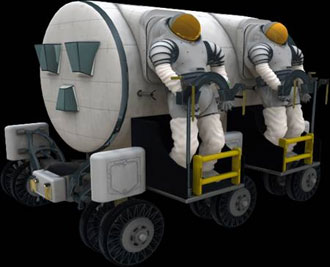
NASA has even generously provided an image of a proposed lunar rover with two integrated suitports, as seen above. The agency feels that such technology will be required for any ‘return’ trips to the Moon or for landing on and exploring other planets. As with the space radiation shield that will also be required for any ‘return’ trips to the Moon, NASA offers no explanation for why such technology was not required back in 1969.

Moving on then to the lunar module’s propulsion system, we are informed that “the LEM was equipped with two very different rockets. The first, the so-called descent engine, would take the LEM from the command module down toward the lunar surface. It was an entirely new and untried piece of technology.” Adds talking-head Stoff, “Up until this point in history, no one had ever built a rocket engine with a throttle. Either they were on or they were off.”
Since the LEMs never had to actually perform as advertised, it’s doubtful that they actually had a throttle. It’s doubtful that they even had engines. We’re going to play along though and pretend as though they did.
Lynn Radcliffe, who managed the facility at White Sands that was specially constructed to test and develop the LEM’s rocket engines, describes the technology required to land the lunar modules: “This was an unbelievable maneuver when you stop and think about it. You’re sitting on a column of thrust, just hovering there, like a, a helicopter, and then as you let it go, the throttle, a little bit, you lower it just a few feet per second until you make contact. All of this is an amazing set of requirements to put on anyone trying to design a rocket.”
Radcliffe is absolutely right; I did stop to think about it and it is unbelievable. What’s interesting here though is that when I described the technique that would have been used to land the modules as being very similar to the landing of a helicopter, some of the ‘debunkers’ got their panties all in a wad over it. And yet here we have the guy who oversaw the development of the rocket engines describing the alleged landings in exactly the same manner, so I guess we can safely conclude that he really doesn’t know what he is talking about either.
And Gene Cowart, who served as Boeing’s chief engineer on the lunar rover project from 1969 through 1971, didn’t know what he was talking about either when he noted that the “LEM, when it comes down over the Moon, does not immediately just set down. It hovers over the Moon.” And Charlie Duke, the alleged pilot of the Apollo 16 lunar module, was no doubt mistaken as well when he recently told James May (James May on the Moon) that flying the lander “was like flying a helicopter.”
Amusingly enough, while the landing of the lunar module was being described on Moon Machines, vintage animation from the gang at NASA/Grumman was displayed on the screen. Below are a couple of screen-caps of that animation. As with the verbal descriptions, of course, I’m sure that this is just another case of the folks who actually designed and/or operated the technology being clueless about how it was supposed to work. As many readers are surely aware, the only people who really know how all that technology was supposed to work are modern-day heroes like Phil Pliet and Jay Windbag.
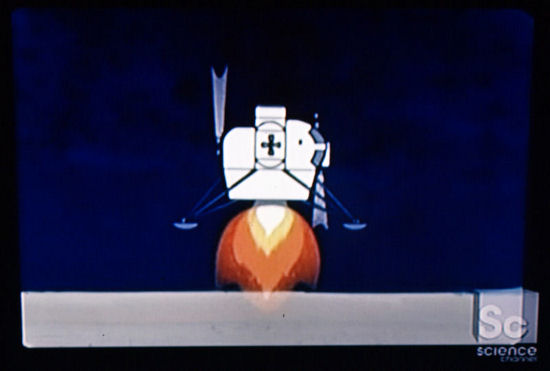
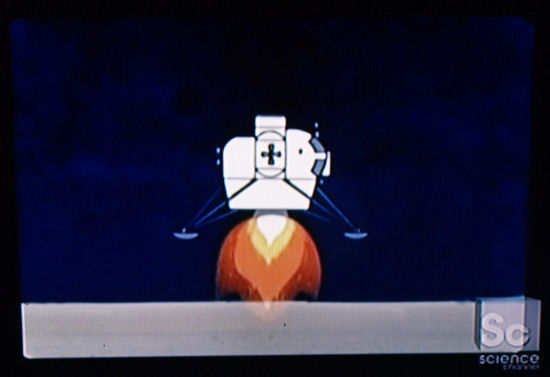
As it turns out, designing that throttle-equipped descent engine was child’s play compared with the task of perfecting the spacecraft’s second rocket engine. As our narrator solemnly intoned, “it was the module’s second rocket, the so-called ascent engine, that caused Grumman the most lost sleep. It didn’t need a throttle, but it did need to work with absolute reliability.”
As Lynn Radcliffe noted, “You’re totally dependent on the ascent engine to work to put you back in orbit. If for any reason the ascent engine failed to work, the astronauts are doomed.” Dick Dunne, Grumman’s Director of Public Relations during the time of the alleged Apollo missions, described the astronauts’ predicament in stark terms: “Two astronauts were going to climb into this thing and essentially they were going to press a button, and if it worked, it worked, and if it didn’t, there weren’t many things that they could do about it.”
To keep the operation of the engine as simple as possible, so-called hypergolic propellants were used – which is to say, a fuel and an oxidizer that explode on contact. That simplicity though came at a price: “the fuels were extremely toxic.” What most concerned Grumman’s engineers was “that the fuel was so corrosive that at the end of a test, each engine had to be rebuilt. It meant the final assembly of an engine could never be tested!”
“Unbelievably,” explains Radcliffe, “the first time these engines would ever have been fired, ever – no check-out at the factory – the first time would be when they were fired on their mission.” As Dunne noted, “I don’t think that anyone could, at that time, tell you 100% that it was gonna work.”
Seeing as how the engines were completely untested – both in terms of being able to operate within the environment of the Moon and in terms of the individual engines being factory tested to see if they worked at all – Dunne’s evaluation would seem to be a bit of an understatement. Luckily though, none of the landers actually made it to the Moon, so whether the engines worked or not is a bit of a moot point.
Another problem the Grumman team faced was how to adequately insulate the vehicle from the intense heat of the unshielded sun (there was, curiously enough, no mention throughout the hour about the necessity of shielding the craft from space radiation). As Stoff noted, “You have to insulate the spacecraft as well as possible because there’s huge fuel tanks in there and the fuel’s gonna boil [if not adequately protected].” Also, we are informed, the huge temperature variations on the Moon “could also cause the craft to buckle.” Unmentioned was that it could be a wee bit uncomfortable for the astronauts as well.
Since weight was an issue, heavy heat shields could not be used. Luckily though, “Dupont had developed this new material – it was aluminized Mylar. It was a gold color, and they found if you built it up to perhaps twenty-five layers, it’s an excellent insulator.” Dupont’s space-age material, as we all know, can be obtained pretty inexpensively these days. And it’s still a very lightweight material. I wonder why it is then that you rarely see spaceships wrapped in it anymore?
Meanwhile, down in Texas, astronauts had been training on a simulator that was supposed to teach them to land the lunar module. Unfortunately, the simulator was “unstable and dangerous” and never worked properly. No one ever actually landed the contraption – but on the plus side, there is lots of film stock of fiery simulator crashes. Stoff notes that, “At some point in the program, [NASA] eventually stopped using it because it was just, it was a lot safer to land on the Moon than it was to fly this machine down in Texas.”
Of course it was. Why waste time with a simulator when the real thing was going to be so much easier? And NASA, no doubt, knew that that would be the case before we even faked going to the Moon. I’m pretty sure that Armstrong was pulled aside and told: “Don’t worry about almost being killed in that simulator. The real thing is going to be so much easier. You’ll see when you get up there. Just trust us on this one. And we’re fairly certain that there is at least a slim possibility that the ascent engine will work when it’s time for you and Buzz to come home. Unless, you know, you guys happen to get a dud. There’s really no way for anyone to know for sure until you get there and try to fire it up. Have a safe trip.”
In the summer of 1967, the first space-ready LEM was delivered to Cape Kennedy to be loaded aboard the Apollo 4 launch vehicle. Incredibly, it had taken less than five years to get “the most complicated and sophisticated spacecraft ever conceived” from the chalkboard to the launch pad! And in the mid-1960s no less! (By the way, I happened to stumble across this image of Apollo 4 sitting on the launch pad. It is, I have to say, a mighty impressive shot. Kudos to the non-astronaut photographer who snapped it.)
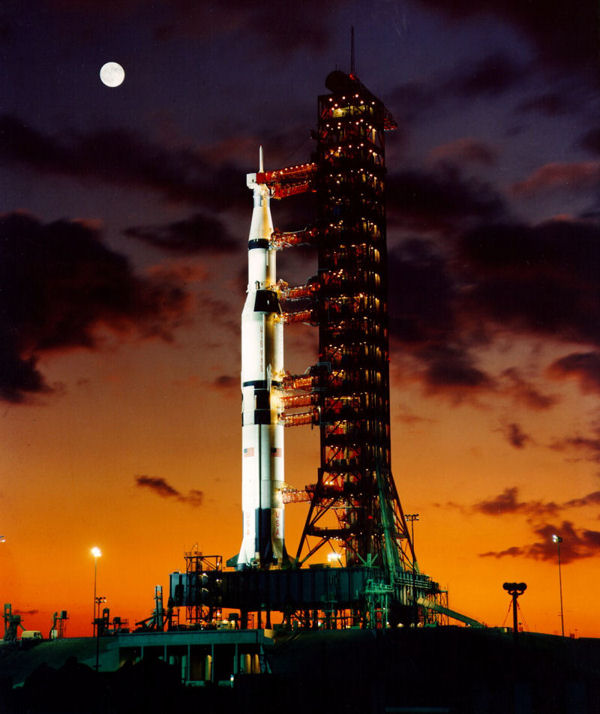
The lunar module never made it aboard that impressive looking rocket ship. Upon delivery, the module was found to have “hundreds of problems,” including bad wiring, faulty parts, an abundance of poor workmanship, and, most alarmingly, serious leaks throughout the fuel system. Grumman had neglected, it seemed, to perform any pre-flight checks. Worse yet, as Grumman’s team raced to correct the numerous problems, a pressure test caused a window to blow out, blasting jagged holes in the skin of the craft and sending debris flying throughout the formerly dust-free module.
The cause of the blowout was never determined. NASA and Grumman though decided to take the “Fuck it! What’s the worst that could happen?” approach and merely replaced the window and ignored the failed pressure test, making no design changes to the modules. After all, there was a timetable to adhere to.
In the end, as we all know, the lunar modules performed flawlessly. According to legend, Neil Armstrong, ever the cool one, set the first LEM down with barely fifteen seconds of fuel remaining in the tank. And when he and Buzz fired up that ascent engine for the very first time, it popped them off the surface of the Moon as if they were riding on a champaign cork. As it turned out though, the lunar module had not yet faced its toughest challenge.
In the spring of 1970, fittingly enough on April 13, Apollo 13’s command and service modules were allegedly rendered powerless by an explosion on the ship while cruising through space some 200,000 miles from home (though in official NASA footage, the windows of the module are filled with blue light, not the blackness of space). The oxygen tank explosion was allegedly powerful enough to do serious damage to the exterior of the craft, but apparently not powerful enough to alter the course of the ship. That was a lucky break for the guys.
The three-man crew allegedly retreated to the two-man LEM, which, as we know, had its own oxygen and fuel supplies. Not only did the LEM allegedly keep the brave trio alive, but its descent engine was allegedly used to ‘slingshot’ the crippled spacecraft around the Moon and set in on a course back to Earth!
Their ordeal wasn’t over though. While camped out in the LEM, the Apollo 13 astronauts were allegedly faced with another life-threatening situation: carbon dioxide was rapidly building in the ship’s confined airspace. Lithium hydroxide cartridges were supposed to remove the carbon dioxide, but there was a limited supply of said cartridges in the LEM. Luckily though, there were additional cartridges in the command module. But they were incompatible; the command module’s cartridges were square while those in the LEM were round.
What to do then? According to Moon Machines, the brain-trust down at mission control had a brilliant idea: “NASA suggested using duct tape and tubing from the spacesuits to jury-rig a connection … (dramatic pause) … It worked!”
I, needless to say, was just being a smart-ass when I said that all we needed back in the 1960s was a roll of duct tape and we could MacGyver those spaceships to the Moon and back. NASA, on the other hand, is dead serious when it says that it was indeed a roll of duct tape that got the Apollo 13 crew home safe and sound – with, needless to say, a huge assist from that spunky little lunar module, which not only powered the flight home but also kept three astronauts alive for nearly 100 hours when it was only designed to keep two men alive for 50 hours!
There seems to be some controversy, however, on exactly how the cartridges were MacGyvered. According to Lovell, who was on the Apollo 13 flight, “we did it with duct tape, with a piece of plastic, and a piece of cardboard, and an old sock.” The key ingredient here seems to be the duct tape. It would probably be fair to say that with a roll of duct tape and any other two random items, you could fix most problems that might arise on a spaceship.
Moving on then to the other Science Channel offering, a 2005 effort entitled First on the Moon: The Untold Story, we learn that Mission Control at the Johnson Space Center in Houston, Texas “was not as high-tech as it looked.” On television, it looked pretty damned impressive, for the era at least. As anyone alive at the time recalls, what the world saw was an enormous room filled with computer consoles, each staffed by a key member of the Apollo team diligently monitoring his computer screen for any signs of trouble.
But in reality, as Apollo 11 computer engineer Jack Garman clues us in, “the computer screens that we looked at in Mission Control weren’t computer screens at all. They were televisions. All the letters, or characters, [they] were all hand drawn. I don’t necessarily mean with a brush, but I mean they were painted on a slide.” But they sure looked pretty damned impressive.
Jack Garman, by the way, was not just some random, low-level computer hack recruited by the Science Channel to offer commentary. According to the official legend, Garman was the guy on the Apollo 11 crew who cleared the Eagle to land despite the fact that multiple alarms were going off. That would tend to indicate that he was a pretty important player at Mission Control.
Every one of those consoles on the floor of Mission Control was powered by a single mainframe computer – a single mainframe computer that had the computing power of a single laptop computer. Actually, make that a 2005-era laptop computer. And the spaceship itself, that multi-staged engineering marvel, carried a computer roughly equivalent to what powers a modern digital watch. Total memory capacity was about 72 kilobytes, or just about enough to hold one of the smaller images on this page.
As I was typing these very words, I realized that I was doing so on a genuine, vintage 2005 laptop computer. If I were inclined to wear digital watches, which I am not, I would now be holding in my hands all the computing power needed to get me and a couple friends to the Moon and back. If we utilized the power of my desktop computer as well, and went down to the Party Store to get a few rolls of Mylar, we could probably make it all the way to Mars and back. How cool is that?
Another curious fact that First on the Moon made note of was that, according to Harold Loden, Apollo 11 mission controller, “The skin on the crew cabin [of the lunar module] was very thin, and that was all done because of weight savings.” Another talking-head added that, “If you really took your finger and poked hard at it, you could poke right through the outer skin of the spacecraft. It was about the thickness of two layers of aluminum foil.” Project Manager Thomas Kelly concurred, noting that “the skin, the aluminum alloy skin of the crew compartment was about 12/1000s of an inch thick. That’s equivalent to about three layers of Reynold’s Wrap that you would use in the kitchen.”
It’s difficult to see then why that window would have blown out during the LEM pressure test. You would think that the guys at Grumman would have securely duct-taped it to the, uhmm, fuselage. And I’m also sure that, had the window not blown out and released the pressure, the rest of the ship would have passed the pressure test with flying colors.
It would appear that what was deployed by the mother ship to shuttle our guys down to the Moon was essentially an oversized Jiffy-Pop container (with the brainpower of a digital watch). The show’s narrator was quick to point out that the astronauts had to be very careful while moving about in their bulky suits lest they puncture or otherwise damage the delicate skin of the craft. What wasn’t pointed out was that the vacuum of space had to be very careful as well – careful not to rip the pressurized craft to shreds the instant it was deployed!
One would logically assume, by the way, that the LEMs would have been kept safely tucked away within the mother ship until lunar orbit was achieved. But according to NASA, that’s not the case. The official legend holds that the lunar modules were deployed shortly after leaving Earth orbit, about three hours after blasting off, and that they then docked in a nose-to-nose configuration with the command and service modules while both spacecraft were flying through the vacuum of space at either 17,000 or 25,000 miles per hour, depending on the source.
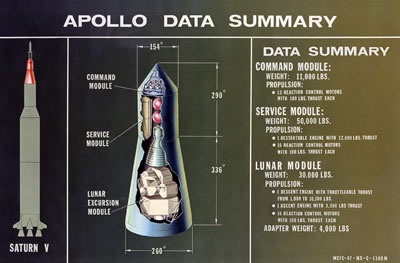
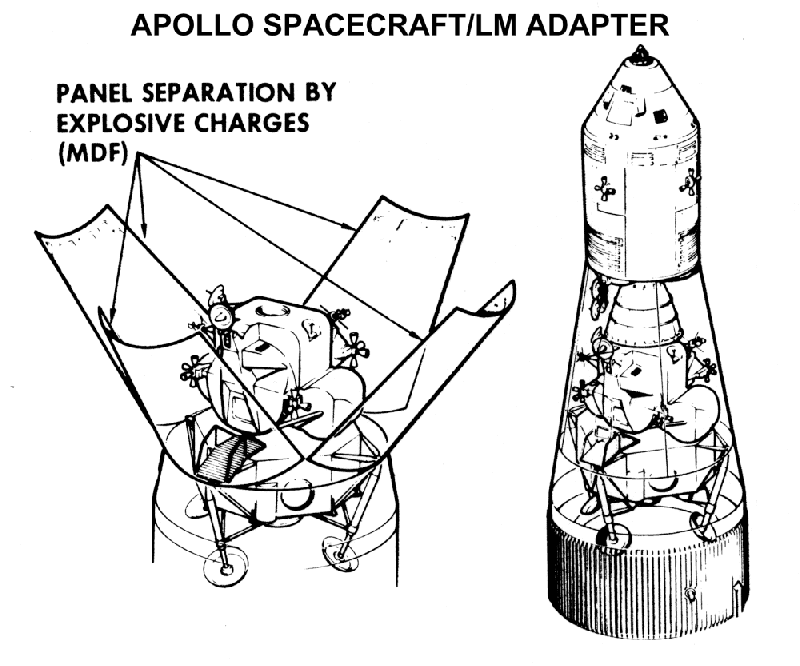
In other words, for virtually the entire 234,000-mile journey from the Earth to the Moon, that flimsily constructed lunar module essentially served as the front bumper of the mother ship. Other than to allow for the creation of the “little engine that could” fable surrounding Apollo 13, which holds that the conjoined spaceships flipped over and the front bumper became the engine, it makes little sense why that would have been done. Not only would it have exposed the fragile lunar modules to the hazards of a lengthy space flight, it would also have required a docking maneuver in outer space (one that seems to go unmentioned in the majority of the Apollo literature).
Amazingly enough, not only were the lunar modules capable of making soft manned landings on the Moon, and of blasting off from the surface of the Moon, and of rendezvousing and docking with the mother ship while in lunar orbit, but they were also capable of docking with the mother ship while cruising from the Earth to the Moon! By my count, those spunky little modules had to dock no fewer than seventeen times during the various Apollo missions, and they performed perfectly every time (twice in Earth orbit on the Apollo 9 mission, and twice on each of the Apollo 10-17 missions, except for Apollo 13, which did not complete the second docking maneuver).
Let’s pause here for a brief moment to reflect on the alleged plight of the unlucky Apollo 13 crew. There were no seats in the LEM as it had been decided that they would just add unnecessary weight. And there is just barely room for two guys in the space allegedly being occupied by three. All three, had this have been a real life-and-death situation, would have been wearing bulky spacesuits, boots, gloves and helmets. Somehow, they had to coexist for four days. During that time, all that would have separated them from the extreme hazards of outer space was a double layer of aluminum foil. One micrometeorite or one misplaced elbow would result in immediate death for the trio.
As the narrator informs us during When We Left Earth, “If the flight suit fails or even tears a little, the difference in pressure will cause the astronaut’s blood to boil, killing him instantly.” The same would be true, of course, about the skin of the spacecraft: the smallest tear would mean instant death for all three. Of course, their suits would have allegedly provide a second line of defense, except that, as can be seen in one of the handful of Apollo 13 mission photos released by NASA, the astronauts weren’t bothering to wear their suits as they cheerfully went about the business of MacGyvering their spaceship.
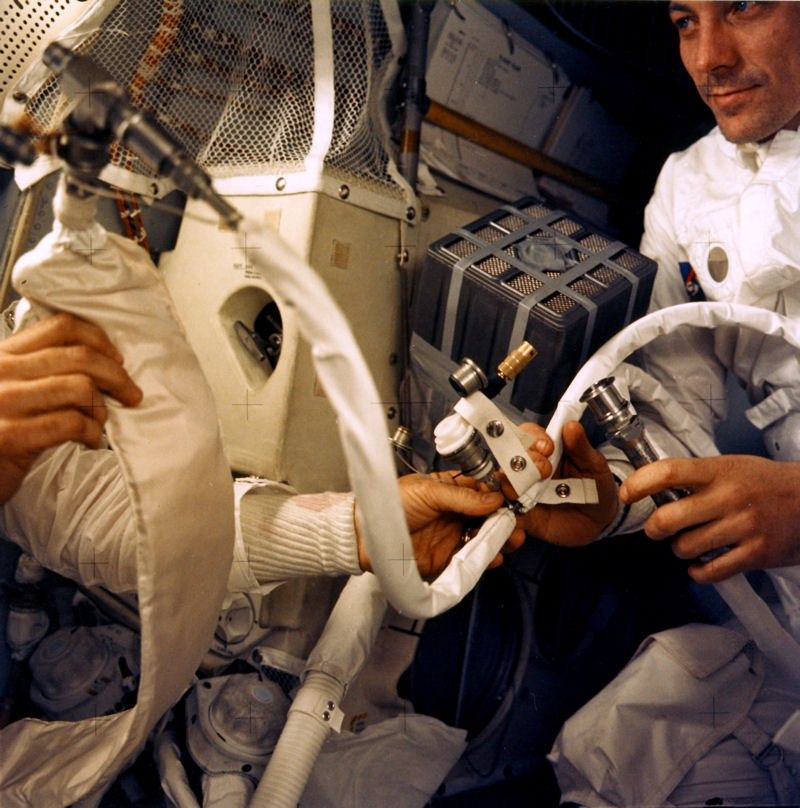
As we already know, their cockiness was entirely justified since that aluminum foil capsule provided all the protection the astronauts needed to get home safely. No fewer than eight lunar modules allegedly made the hazardous voyage to the Moon, and all of them arrived in immaculate condition. The Apollo 13 lunar module was exposed throughout virtually the entire mission – all the way to the Moon and all the way back. In all, the eight LEMS allegedly logged some 2,000,000 miles of unprotected space flight and not one of them suffered so much as a scratch. That, my friends, is 1960’s technology at its finest.
No comments:
Post a Comment